Citation: Mohamed Jaffer Sadiq Mohamed, Denthaje Krishna Bhat. A facile microwave approach to synthesize RGO-BaWO4 composites for high performance visible light induced photocatalytic degradation of dyes[J]. AIMS Materials Science, 2017, 4(2): 487-502. doi: 10.3934/matersci.2017.2.487
| [1] | Mohamed Jaffer Sadiq Mohamed, Denthaje Krishna Bhat . Novel ZnWO4/RGO nanocomposite as high performance photocatalyst. AIMS Materials Science, 2017, 4(1): 158-171. doi: 10.3934/matersci.2017.1.158 |
| [2] | Yana Fajar Prakasa, Sumari Sumari, Aman Santoso, Muhammad Roy Asrori, Ririn Cahyanti . The performance of radar absorption of MnxFe3–xO4/rGO nanocomposites prepared from iron sand beach and coconut shell waste. AIMS Materials Science, 2023, 10(2): 227-248. doi: 10.3934/matersci.2023013 |
| [3] | Muhammad Yakob, Hamdani Umar, Puji Wahyuningsih, Rachmad Almi Putra . Characterization of microstructural and optical CoFe2O4/SiO2 ferrite nanocomposite for photodegradation of methylene blue. AIMS Materials Science, 2019, 6(1): 45-51. doi: 10.3934/matersci.2019.1.45 |
| [4] | Ririn Cahyanti, Sumari Sumari, Fauziatul Fajaroh, Muhammad Roy Asrori, Yana Fajar Prakasa . Fe-TiO2/zeolite H-A photocatalyst for degradation of waste dye (methylene blue) under UV irradiation. AIMS Materials Science, 2023, 10(1): 40-54. doi: 10.3934/matersci.2023003 |
| [5] | Evangelos Karagiannis, Dimitra Papadaki, Margarita N. Assimakopoulos . Circular self-cleaning building materials and fabrics using dual doped TiO2 nanomaterials. AIMS Materials Science, 2022, 9(4): 534-553. doi: 10.3934/matersci.2022032 |
| [6] | Haiqing Yao, Fei Li, Jodie Lutkenhaus, Masaya Kotaki, Hung-Jue Sue . High-performance photocatalyst based on nanosized ZnO-reduced graphene oxide hybrid for removal of Rhodamine B under visible light irradiation. AIMS Materials Science, 2016, 3(4): 1410-1425. doi: 10.3934/matersci.2016.4.1410 |
| [7] | Khang Duy Vu Nguyen, Khoa Dang Nguyen Vo . Magnetite nanoparticles-TiO2 nanoparticles-graphene oxide nanocomposite: Synthesis, characterization and photocatalytic degradation for Rhodamine-B dye. AIMS Materials Science, 2020, 7(3): 288-301. doi: 10.3934/matersci.2020.3.288 |
| [8] | Carlos N. Kabengele, Giresse N. Kasiama, Etienne M. Ngoyi, Clement L. Inkoto, Juvenal M. Bete, Philippe B. Babady, Damien S. T. Tshibangu, Dorothée D. Tshilanda, Hercule M. Kalele, Pius T. Mpiana, Koto-Te-Nyiwa Ngbolua . Biogenic synthesis, characterization and effects of Mn-CuO composite nanocatalysts on Methylene blue photodegradation and Human erythrocytes. AIMS Materials Science, 2023, 10(2): 356-369. doi: 10.3934/matersci.2023019 |
| [9] | Álvaro Guzmán Aponte, María A Llano Ramírez, Yuliana Cadavid Mora, Juan F Santa Marín, Robison Buitrago Sierra . Cerium oxide nanoparticles for color removal of indigo carmine and methylene blue solutions. AIMS Materials Science, 2020, 7(4): 468-485. doi: 10.3934/matersci.2020.4.468 |
| [10] | Liang Wu . Cu-based mutlinary sulfide nanomaterials for photocatalytic applications. AIMS Materials Science, 2023, 10(5): 909-933. doi: 10.3934/matersci.2023049 |
The wastes discharged from various industries and plants are the major source of water pollution, ringing alarm bells for human society. Organic dyes are mainly used in industries related to textile, cosmetics, paper, pharmaceuticals, food, printing and dyeing. Around 20% of these dyes are lost during the process of coloring. Since these are lost into the water their removal from the water sources has become a major environmental issue [1,2]. For the treatment of hazardous wastes, several conventional methods like reverse osmosis, adsorption, ultra filtration, coagulation by chemical agents, enzymes, etc, are used [3,4,5,6,7]. But these nondestructive processes just transfer the pollutants from one phase to another, creating secondary pollutants. Hence for mineralization of the organic dyes with aromatic moieties, an eco-friendly cost effective method has to be implemented in large scale. Photocatalysis is one such process which has been looked into for a past couple of decades, but the high recombination rate of photo generated electrons and holes has prevented it from commercialization of the application [8,9,10].
Semiconducting materials with narrow band gap have been used as photocatalyst since the band gap energy corresponds to the UV or visible light region of the solar spectrum and also they help in charge separation. Materials like TiO2, ZnO, Fe2O3, NiO, Co3O4, CeO2, ZrO2 have tunable physical and optical properties [11,12,13,14,15,16]. Among these, TiO2 is a well-known photocatalyst with high chemical stability, non toxicity, photo corrosion resistivity and low cost. But it suffers from the disadvantage of having a wide band gap of 3.2 eV which leads to absorption of only a very small portion of the solar energy and has a higher recombination rate of electron-hole pairs. Multi metal oxides like SrTiO3, LaFeO3, NaTaO3, BaFeO3, K4Nb6O17, CaIn2O4, CaBi2O4 and BiVO4 have also been used for photodegradation of organic pollutants [15,17]. Of late M2+WO4 type metal tungstates is under the research radar and nano/micro structured materials like CdWO4, ZnWO4 and NiWO4 have been applied in variety of areas [1,15,18,19].
BaWO4 which has a wide variety of applications in the field of lasers, catalysis, scintillators, fluorescent lamps, photoluminescence and optical fibers, have been studied very less in the field of photocatalysis [20]. Although several methods of preparation have been reported for this material such as Czochralski, precipitation, hydrothermal, solid state and pulsed laser deposition the material still suffered instability and slow electron transfer rate. Since visible region of the solar spectrum is more dominant, BaWO4 which is a UV catalyst has to be transformed to visible light absorbing entity to make it more applicable [20]. For visible light absorption the band gap has to be small which means the recombination rate will be very high. By doping carbon containing species the transport property and the recombination rate can be altered desirably to improve the photocatalytic efficiency [1,18,19].
Graphene known to be mother of all 2D materials has excellent properties [21,22]. Reduced graphene oxide (RGO) can be prepared from graphene oxide (GO) via Hummer's and modified Hummer's method during which metal and metal oxides can be added to decorate the nanosheets [23,24]. RGO can act as a support system in the composite while also retaining the photogenerated electron thus reducing the recombination rate of electron-hole pair; it improves the adsorption of the dye molecules via π-π interaction. Several RGO based nanocomposites have been reported for photocatalytic applications but to the best of our knowledge RGO-BaWO4 composites have not yet been studied for their photocatalytic performance [24].
Microwave approach of synthesis has an upper hand over the conventional thermal synthesis due to the factors like microwave irradiation directly heats the material rather than heating the reaction vessel and hence consumes less energy and time; uniform heating; selective heating; acceleration in reaction rate and high chemical yield. Recently, microwave approach has been used to synthesize RGO, metal tungstates and RGO hybrid composites for application in the field of photocatalysis, hydrogen generation and supercapacitors [21,25,26].
In view of the aforesaid facts, we thought it is worthwhile to synthesize RGO-BaWO4 composites of varied compositions using microwave approach. The as synthesized materials were characterized using X-ray diffraction (XRD), Scanning electron microscopy (SEM), Energy dispersive X-ray (EDX) analysis, X-ray photoelectron spectroscopy (XPS), Raman spectroscopy to determine the phase structure, morphology and elemental composition. Photoluminescence spectroscopy (PL) and Diffuse reflectance spectroscopy (DRS) techniques were used to study their optical properties. The photocatalytic activity was studied through photodegradation of methylene blue (MB) and methyl orange (MO) dyes under visible light. The stability and reusability of the composites were also determined. A reaction mechanism was proposed based on active species trapping experiment to determine the species involved in photocatalytic degradation of dyes.
All the reagents procured were of analytical grade and utilized without further purification. Deionized water was utilized for all the experiments.
GO was synthesized as reported earlier using modified Hummer's method [27,28]. The typical procedure is as follows: graphite flakes (about 1 g) was mixed well with KMnO4 (about 4 g). To this conc. sulphuric acid (90 mL) was added slowly in about 30 minutes under magnetic stirring. The mixture was further stirred for 12 h after which deionized water (80 mL) and hydrogen peroxide (30%) were added till the color changed from greenish purple to bright yellow. This suspension was centrifuged and the supernatant was decanted. The precipitate was washed with water and hydrochloric acid (10%). It was vacuum dried at 60 ℃ for 12 h.
In a typical experiment, Ba (CH3COO)2 and Na2WO4·2H2O each was dissolved in 20 mL mixture of ethylene glycol and water (1:1) under magnetic stirring for about 20 minutes at room temperature. 0.005 M solutions (20 mL each) of both were mixed to which calculated amounts of exfoliated GO was added and stirred for 30 minutes to prepare a series of xRGO-BaWO4 composites where x = 0, 1, 2.5, 5 and 10. The exfoliation of GO was done by ultrasonicating the GO solution for 30 minutes. The solution containing GO, Ba (CH3COO)2 and Na2WO4·2H2O was then taken into a 100 mL reactor and irradiated with microwave of 350 W for 2 minutes. After the solution cooled down naturally the precipitate was collected by centrifuging. It was washed with water and ethanol (10%) several times and vacuum dried at 60 ℃ for 12 h. The prepared samples were denoted as 1% RGO-BaWO4, 2.5% RGO-BaWO4, 5% RGO-BaWO4 and 10% RGO-BaWO4, respectively, with the number referring to the weight ratios of RGO to BaWO4. A control sample of BaWO4 was synthesized using a similar process without addition of GO.
The crystal structures of RGO-BaWO4 composites were determined by XRD (X-6000, Shimadzu) with Cu Kα radiation (λ = 0.154 nm). The morphologies of the composites were examined with a SEM (JEOL JSE-6390) well equipped with EDX operated at a voltage of 15.0 kV. The elemental composition of the composites was determined using XPS (XPS, Kratos XSAM800) equipped with standard and monochromatic X-ray sources (Al-Kα). Raman spectra were obtained by Horiba Jobin Yvon, Japan at room temperature using a 532 nm laser as radiation source. DRS of the composites were recorded by utilizing UV-visible spectrometer (Analytik Jena). The room temperature PL spectra of the composites were obtained by using a Horiba Jobin Yvon PL instrument. The specific surface area of the samples was measured on SMART SORB 92/93 (Smart Instruments Company Private Limited, INDIA) using Brunauer-Emmett-Teller (BET) method.
The photocatalytic performance of the RGO-BaWO4 composites was determined in visible light region by the degradation of MB and MO solution. A pyrex glass photocatalytic reactor furnished with water cooled immersion tube, 250 W Hg lamp (emission range from 300 to 800 nm), cut-off filter of wavelength 400 nm and sample extracting facility was utilized to illuminate the suspension (100 mL) containing the dye (10 mg/L) and the photocatalyst (0.1 g). The reaction mixture was maintained at a pH of 3 using 0.1 N H2SO4. The suspension was allowed to achieve adsorption-desorption equilibrium by stirring it for 30 minutes in dark. Once the solution is irradiated at regular intervals, 4 ml of the suspension is withdrawn. It is centrifuged and the supernatant is subjected to UV-visible analysis. The photodegradation efficiency was estimated according to the equation, degradation % = [(C0-C)/C0] × 100, where C0 represents the initial concentration of the dye and C represents the concentration of the dye after irradiation at time interval "t".
The XRD patterns of graphite, GO, RGO, BaWO4 and RGO-BaWO4 composites with various RGO weight proportions are shown in Figure 1. The XRD pattern of GO revealed only one sharp peak. The diffraction peak (002) of GO is situated at 2θ = 10.5° with d-spacing of about 0.842 nm. This value of d-spacing is larger than that of pristine graphite (0.339 nm) indicating the presence of intercalated oxygen containing functional groups [29]. The absence of peaks corresponding to graphite in GO pattern indicates that graphite has been completely oxidized to GO. The diffraction peaks corresponding to RGO-BaWO4 composite can be indexed to scheelite type tetragonal crystal of BaWO4 with space group Ⅰ41/a indicating that incorporation of BaWO4 into RGO matrix does not change the crystal structure of the former. The diffraction peaks found at 2θ values 17.25°, 26.45°, 28.06°, 31.87°, 42.97°, 45.68°, 48.69°, 53.57°, 54.48°, 66.59°, 67.74°, 69.36°, 73.0°, 73.77°, 75.75° and 76.83° can be ascribed to (101), (112), (004), (200), (204), (220), (116), (312), (224), (400), (208), (411), (332), (404), (420) and (228) planes of BaWO4 (JCPDS card no. 43-0646), respectively. The absence of impurity peaks indicated the high purity of the samples.
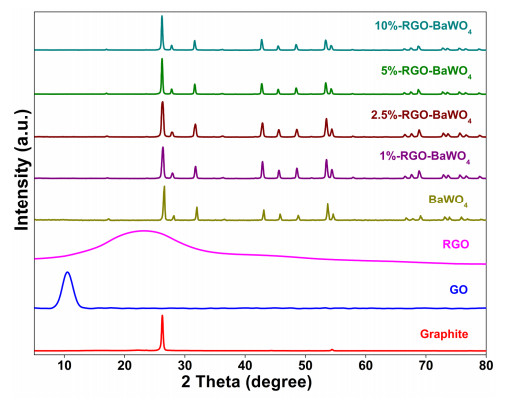 Figure 1. XRD patterns of the graphite, GO, RGO, BaWO4 and RGO-BaWO4 composites of different compositions.
Figure 1. XRD patterns of the graphite, GO, RGO, BaWO4 and RGO-BaWO4 composites of different compositions.The morphologies of the BaWO4 and RGO-BaWO4 composites were studied using SEM (Figure 2). The SEM image reveals narrow elliptical BaWO4 particles. In the composite we notice the BaWO4 particles wrapped in RGO sheets. The elemental composition was found to be C, Ba, W and O by EDX analyses (Figure 3). Ba, W and O were present in the ratio 1:1:4 indicating the presence of BaWO4. Elemental mapping of C, Ba, W and O using spot EDX revealed uniform distribution of BaWO4 in RGO matrix in RGO-BaWO4 composites (Figure 3a-d).
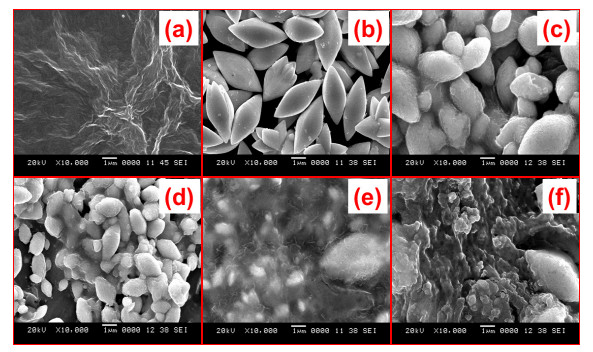 Figure 2. SEM images of (a) Pure RGO, (b) Pure BaWO4, (c) 1% RGO-BaWO4 composite, (d) 2.5% RGO-BaWO4 composite, (e) 5% RGO-BaWO4 composite, (f) 10% RGO-BaWO4 composite.
Figure 2. SEM images of (a) Pure RGO, (b) Pure BaWO4, (c) 1% RGO-BaWO4 composite, (d) 2.5% RGO-BaWO4 composite, (e) 5% RGO-BaWO4 composite, (f) 10% RGO-BaWO4 composite.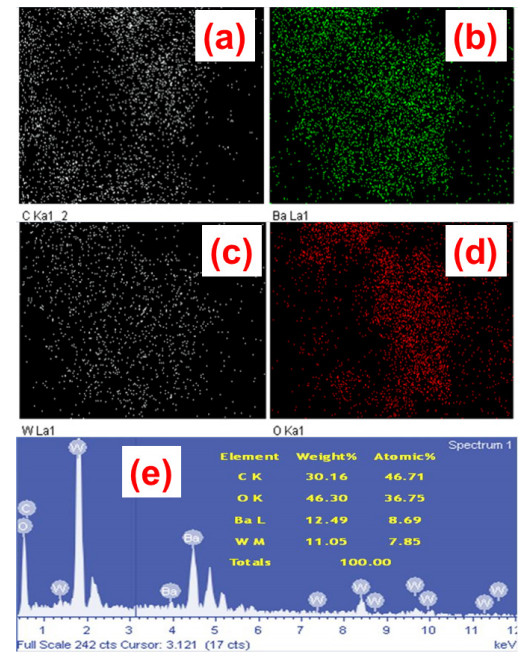 Figure 3. Spot EDX of (a) C; (b) Ba; (c) W; (d) O in the RGO-BaWO4 composites; (e) EDX spectrum of RGO-BaWO4 composites.
Figure 3. Spot EDX of (a) C; (b) Ba; (c) W; (d) O in the RGO-BaWO4 composites; (e) EDX spectrum of RGO-BaWO4 composites.XPS is a highly sensitive surface technique used to determine the elemental composition, chemical and electronic state of the element within a material. The XPS survey spectrum (Figure 4a) of RGO-BaWO4 composite exhibits peaks corresponding to C 1s, O 1s, Ba 3d and W 4f. The high resolution deconvoluted C 1s XPS spectra for GO (Figure 4b), reveals four peaks located at 284.6 eV, 285.8 eV, 286.9 eV and 288.7 eV which corresponds to the C-C (sp2 bonded carbon), C-OH (hydroxyls), C=O (carbonyls) and O-C=O (carboxyl) functional groups, respectively indicating high oxygen content on the surface [18]. High resolution deconvoluted C 1s spectrum of RGO-BaWO4 (Figure 4c) reveals a peak around 284.6 eV, corresponding to C-C (sp2 bonded carbon). The intensity of peaks corresponding to the oxygen functional groups decreased drastically indicating the reduction of GO into RGO successfully [19].
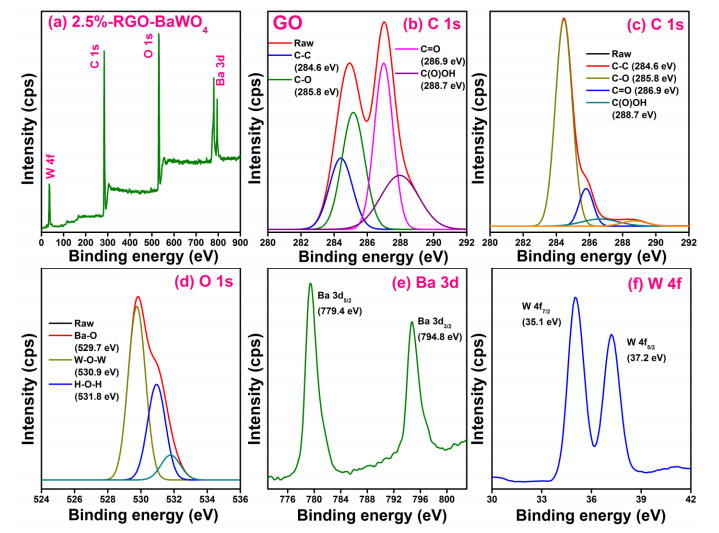 Figure 4. (a) XPS survey spectrum of the RGO-BaWO4 composite; (b) XPS spectrum of GO C 1s; XPS spectrum of RGO-BaWO4 composite (c) C 1s; (d) O 1s; (e) Ba 3d; (f) W 4f.
Figure 4. (a) XPS survey spectrum of the RGO-BaWO4 composite; (b) XPS spectrum of GO C 1s; XPS spectrum of RGO-BaWO4 composite (c) C 1s; (d) O 1s; (e) Ba 3d; (f) W 4f.The high-resolution Ba 3d spectrum (Figure 4d) comprises of two peaks at 779.4 eV and 794.8 eV, corresponding to Ba 3d5/2 and Ba 3d3/2, respectively. The high-resolution W 4f spectrum (Figure 4e) also comprises of two peaks at 35.1 eV and 37.2 eV, which corresponds to the W 4f7/2 and W 4f5/2, respectively. The splitting energy between the 4f doublet of W is 2.1 eV indicates that W is in +6 state [19]. The high-resolution O 1s spectrum (Figure 4f) consists three peaks at 529.7 eV, 530.9 eV and 531.8 eV, which corresponds to the Ba-O, W-O-W and H-O-H (surface absorbed hydroxyl oxygen species), respectively [1,18].
Raman spectroscopy is a fast and nondestructive technique to obtain vibrational information about the chemical bonds and symmetry of the molecule. The Raman spectra for GO, RGO, BaWO4, and RGO-BaWO4 composite are shown in Figure 5. The Raman spectra of GO reveals two prominent peaks at around 1346.4 cm−1 and 1598.1 cm−1 corresponding to the D band (the breathing mode of the symmetry A1g) and the G band (the E2g mode of sp2 carbon atoms), respectively [18,19]. BaWO4 on the other hand exhibits three peaks around 333.6 cm−1, 794.5 cm−1 and 927.1 cm−1, which corresponds to the Raman active vibrations of Ag, Bg and Eg modes, where A and B are non-degenerate modes while E is doubly degenerate mode [30]. The subscript g refers to the centrosymmetric nature.
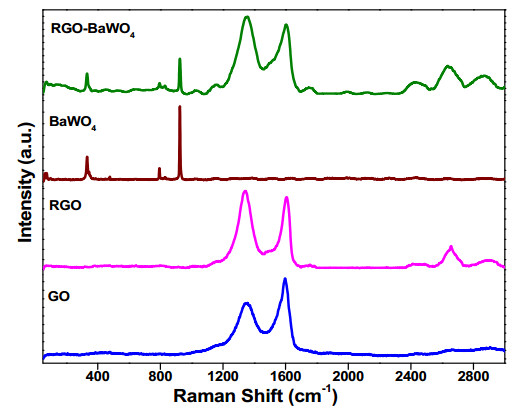 Figure 5. Raman spectra of the GO, RGO, BaWO4 and RGO-BaWO4 composites.
Figure 5. Raman spectra of the GO, RGO, BaWO4 and RGO-BaWO4 composites.Two prominent D and G bands are exhibited around 1339.6 cm−1 and1594.8 cm−1 by RGO and around 1338.2 cm−1 and 1592.5 cm−1 by RGO-BaWO4 composite, respectively. The 2D bands appear at 2653.2 cm−1 and 2639.1 cm−1 in the case of RGO and RGO-BaWO4, respectively. The decrease in the wavenumbers of D and G bands from GO to RGO, indicates the conversion of GO to RGO [18,19]. The further decrease in the wavenumbers after the formation of the composite is due to the smaller size of BaWO4 crystals.
The ID/IG intensity ratio of pure RGO and RGO in RGO-BaWO4composite (1.07 and 1.10, respectively) is slightly greater than that of GO (0.75). This is may be due to the decrease in the sp2 domain size as GO gets reduced to RGO nanosheets [19]. The domain size can be calculated by using equation (1),
| L = 4.4/(ID/IG) | (1) |
where, L = domain size and ID/IG is the intensity ratio of D and G bands. The calculated domain size of GO, RGO and RGO-BaWO4 are 5.87 nm, 4.11 nm and 4.0 nm, respectively.
The number of RGO layers can be determined by the ratio I2D/IG, where I2D is intensity of 2D band and IG is intensity of G band. The ratio I2D/IG of > 2, 1 to 2, and < 1 corresponds to single, double and multi-layer of RGO sheets, respectively. In the present work I2D/IG was found to be 0.34 and 0.42 for RGO and RGO-BaWO4 composite, respectively indicating the multilayered nature of RGO sheets.
The optical properties of the as-synthesized composites were studied using DRS (Figure 6a). The results indicated that BaWO4 absorbs in the UV region while the absorption edge of the RGO-BaWO4 composites shifts towards the visible region with increase in the intensity of absorption. The DRS of pure RGO shows that although its absorption maximum occurs in the UV region it has sufficiently high absorbance in the visible region compared to that of pure BaWO4. Thus, the observed red shift in the absorption edge of the composites may be due to the increasing amounts of RGO in the composites. The results also suggest that BaWO4 is incapable of acting as a photocatalyst in the visible region while the composites can be active in the visible region as photocatalysts due to appropriate band gap.
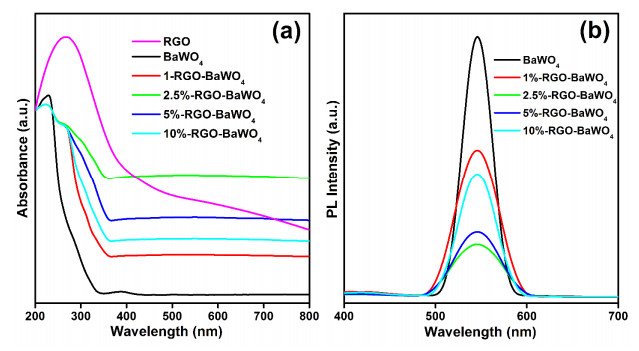 Figure 6. (a) DRS; (b) PL spectra of the BaWO4 and RGO-BaWO4 composites.
Figure 6. (a) DRS; (b) PL spectra of the BaWO4 and RGO-BaWO4 composites.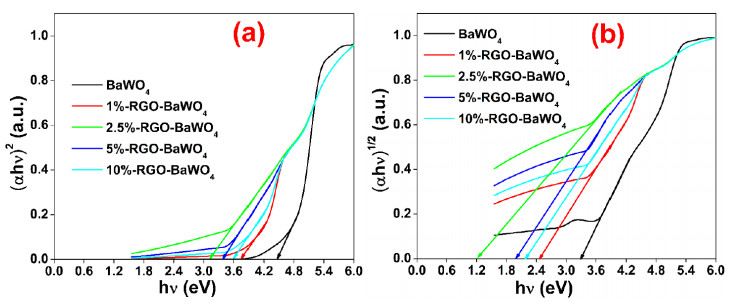 Figure 7. Band gap plots of BaWO4 and RGO-BaWO4composites (a) direct; (b) indirect.
Figure 7. Band gap plots of BaWO4 and RGO-BaWO4composites (a) direct; (b) indirect.The band gap energy was calculated employing the Kubelka-Munk equation (2),
| α (h ν )=A(h ν -Eg)n/2 | (2) |
where α, h, ν, Eg and A are the absorption coefficient, Plank constant, frequency of light, band gap energy and constant, respectively. The "n" value of 1 corresponds to direct and 4 corresponds to indirect transition in the semiconductor material. The band gap is determined by a plot of (αhν)n/2 versus energy of photon (hν). Direct band gap energy of 4.43 eV, 3.76 eV, 3.60 eV, 3.39 eV, 3.13 eV and indirect band gap energy of 3.30 eV, 2.47 eV, 2.19 eV, 1.99 eV, 1.22 eV corresponding to pure BaWO4, 1% RGO-BaWO4, 10% RGO-BaWO4, 5% RGO-BaWO4 and 2.5% RGO-BaWO4 respectively (Figure 7). The values of direct and indirect band gaps indicate that the RGO-BaWO4 composites respond to both UV as well as visible light.
PL spectra can be used to determine the effectiveness of the charge separation and recombination rate of the photogenerated electron hole pairs. If the intensity of PL peak is lower it means the recombination rate is lower [1]. The PL spectra of the as-synthesized BaWO4 composites with various amount of RGO are shown in Figure 6b. The excitation wavelength corresponds to 400 nm while the emission peak is exhibited around 545 nm (green emission). BaWO4 shows highly intense peak indicating high recombination rate. The composites exhibit lower intensity than pure BaWO4. 2.5% RGO-BaWO4 shows very less intensity indicating the low recombination rate of electron hole pairs generated by the visible light irradiation.
The BET surface area analyses of the composite samples were carried out to study the effect of addition of RGO on the overall surface area of prepared nanocomposites. The measured BET surface areas of the samples were, 3.41 m2/g, 14.14 m2/g, 19.45 m2/g, 18.95 m2/g and 15.95 m2/g for pure BaWO4, 1% RGO-BaWO4, 2.5% RGO-BaWO4, 5% RGO-BaWO4 and 10% RGO-BaWO4 respectively. The addition of RGO content initially increased the surface area of the sample up to RGO content of 2.5%. Further additions of RGO did not increase the surface area. This may be due to agglomeration of RGO and BaWO4 in the formed composite.
The photocatalytic degradation of MB and MO were studied in the presence of RGO-BaWO4 in aqueous solution using visible light source. Degradation of dye (ⅰ) in presence of photocatalyst, in the absence of irradiation and (ⅱ) in the absence of photocatalyst with visible light irradiation, were considered as control (blank test). Under visible light irradiation the color of the solution changed with time indicating the photodegradation was in progress. The absorption intensity decreased with time as shown in Figure 8.
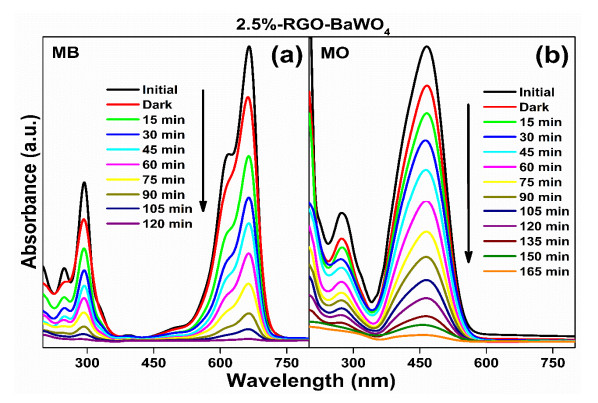 Figure 8. UV-Vis spectra of (a) MB; (b) MO concentration changes with time in the presence of 2.5% RGO-BaWO4.
Figure 8. UV-Vis spectra of (a) MB; (b) MO concentration changes with time in the presence of 2.5% RGO-BaWO4.The absorbance peaks of MB and MO appearing at 664 nm and 464 nm decreased with time and disappeared completely after 120 minutes and 165 minutes, respectively. The photodegradation efficiencies of various catalyst compositions were compared (Figure 9a-b) and it was found that both in the case of MB and MO dye degradation 2.5% RGO-BaWO4 composite showed maximum efficiency.
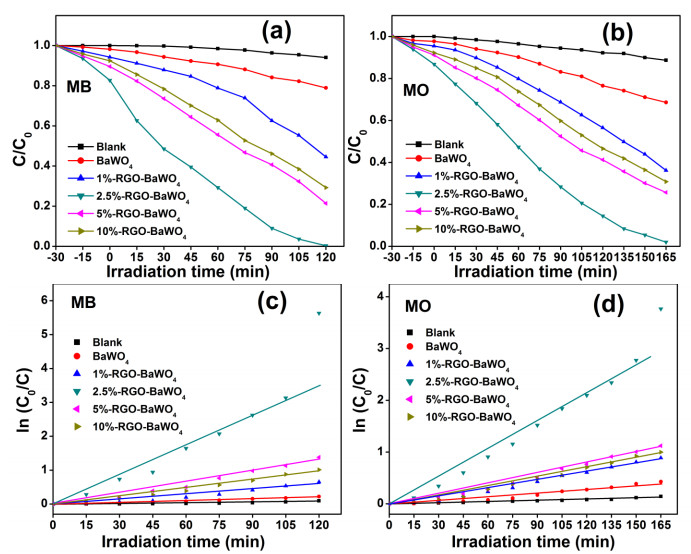 Figure 9. Photocatalytic degradation of (a) MB; (b) MO dye as a function irradiation time; first order kinetic plot of (c) MB and (d) MO dye over different catalysts.
Figure 9. Photocatalytic degradation of (a) MB; (b) MO dye as a function irradiation time; first order kinetic plot of (c) MB and (d) MO dye over different catalysts.The kinetics of the photocatalytic degradation was studied by the first-order simplification [18] of Langmuir-Hinshelwood (L-H) kinetics, employing equation (3),
| ln(C0/C) = kt | (3) |
where C0/C is the ratio between the concentration of the dye molecules at adsorption-desorption equilibrium and at irradiation time "t" and "k" is the first-order rate constant (min−1). The "k" value is found from the plot of ln (C0/C) versus irradiation time "t" (Figure 9c-d). The efficiency of photodegradation of the RGO-BaWO4 composites increased with increasing the RGO contents from 1 to 10 wt% (Table 1). With increase in the RGO content, initially the efficiency of photocatalytic activity increases up to 2.5%. At 2.5% RGO content, the nanocomposite showed higher efficiency compared to other samples. This may be ascribed to the higher surface area available for charge separation which in turn enhances the catalytic efficiency. The decrease in the activity above 2.5% RGO content may be ascribed to the coverage of RGO on the semiconductor material and hence preventing the latter from effective absorption of incident light radiation and causing low activity [8,22]. This results of surface area analyses of the samples also support this statement.
| Catalyst | Rate constant k (min−1) | |
| Methylene Blue | Methyl Orange | |
| BaWO4 | 0.00182 | 0.00319 |
| 1% RGO-BaWO4 | 0.00601 | 0.00664 |
| 2.5% RGO-BaWO4 | 0.03910 | 0.02092 |
| 5% RGO-BaWO4 | 0.01130 | 0.00727 |
| 10% RGO-BaWO4 | 0.00927 | 0.00690 |
As 2.5 % RGO-BaWO4exhibited maximum performance, the photocatalytic stability and reusability of this composite are investigated for five consecutive cycles (Table 2). The photocatalytic activity of MB and MO degradation decreased slightly from 99.70 % to 97.68 % and 97.99 % to 89.59 % after five cycles, which indicates that 2.5 % RGO-BaWO4nanocomposite has excellent reusability. The decreased efficiency may be due to loss of the catalyst during recovery process. Overall, the results indicate that the synthesized composites have excellent recyclability and photocatalytic efficiency.
| Number of Cycles | Efficiency of degradation (%) | |
| Methylene Blue | Methyl Orange | |
| 1 | 99.7 | 98.0 |
| 2 | 99.0 | 97.9 |
| 3 | 98.7 | 94.2 |
| 4 | 98.4 | 91.7 |
| 5 | 97.7 | 89.6 |
The possible photocatalytic mechanisms involved in dye degradation was determined via trapping experiments using the chemicals, 5mM of tertiary butanol (TBA); 5 mM of disodium salt of ethylenediaminetetraaceticacid (EDTA), 5 mM of benzoquinone (BQ) and 10 mM of silver nitrate (AgNO3) to act as scavengers for hydroxyl radicals, holes, superoxide radicals, and electrons respectively during the photocatalytic process [18]. The photodegradation reaction rate showed no much change when TBA was added indicating hydroxyl radicals are not the active species. However, the addition of EDTA, BQ and AgNO3 to the system decreased the efficiency drastically showing that holes and super oxide anion radicals are mainly involved in the photodegradation process (Table 3). As indicated by the results below, a possible schematic scheme for the photocatalytic degradation is given in Figure 10. RGO-BaWO4 composite absorbs the visible light and electron-hole pairs are created in BaWO4. RGO due to its high charge carrier mobility can act as electron acceptor and transporter and delay the recombination of photogenerated electron hole pair. The negatively charged electrons react with dissolved oxygen to produce the superoxide anion radicals (O2·-). The holes react with the water molecules to form hydroxyl radicals (OH·).
| Scavenger | Extent of Degradation (%) | |
| Methylene Blue | Methyl Orange | |
| None | 99.7 | 98.0 |
| TBA | 98.6 | 94.0 |
| EDTA | 73.8 | 63.0 |
| BQ | 54.0 | 46.9 |
| AgNO 3 | 79.2 | 70.5 |
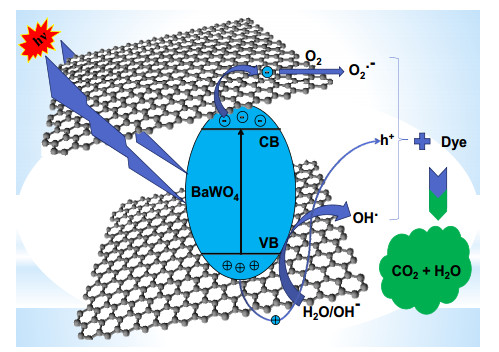 Figure 10. Proposed mechanism for the photocatalytic degradation of dye by RGO-BaWO4 composites.
Figure 10. Proposed mechanism for the photocatalytic degradation of dye by RGO-BaWO4 composites.These active species degrade the dye molecules into products like carbon dioxide and water. The reaction steps are shown in equation 4 to 9.
| BaWO4 + hν→BaWO4(e - + h + ) | (4) |
| BaWO4(e-) + RGO →BaWO4+ RGO (e-) | (5) |
| e-+ O2 →O2.- | (6) |
| OH-+ h+ →OH. | (7) |
| Dye + O2.-+ OH.+ h+→CO2+ H2O | (8) |
A series of RGO-BaWO4 composites with various compositions have been synthesized via microwave irradiation method. The prepared materials have been characterized by diffraction, microscopic and spectroscopic techniques. The photocatalytic activities of the RGO-BaWO4 composites have been studied using MB and MO dye. The dye degradation efficiency has been determined in the presence of visible light. We observed that the RGO-BaWO4 composites with the optimal RGO content of 2.5 wt% shows the maximum photocatalytic performance of dye degradation in comparison to the other ratios studied. The improved photocatalytic performance of the BaWO4 is due to the increase in visible light absorption range and the reduction in recombination rate of photogenerated electron-hole pair due to the composited RGO. The photocatalytic degradation mechanism involved superoxide anion radical and holes as the active species. The synthesized RGO-BaWO4 had excellent stability and reusability. Hence, the above results indicate that RGO-BaWO4 composite can be a promising eco-friendly photocatalytic material for the treatment of organic dyes.
The author M.M.S.J. acknowledges the financial support from the National Institute of Technology Karnataka, Surathkal in the form of research fellowship.
The authors declare no competing financial interest.
| [1] |
Sadiq MMJ, Bhat DK (2017) Novel ZnWO4/RGO nanocomposite as high performance photocatalyst. AIMS Mater Sci 4: 158–171. doi: 10.3934/matersci.2017.1.158

|
| [2] |
Molinari R, Lavorato C, Argurio P (2017) Recent progress of photocatalytic membrane reactors in water treatment and in synthesis of organic compounds. A review. Catal Today 281: 144–164. doi: 10.1016/j.cattod.2016.06.047

|
| [3] |
Khan M, Lo IMC (2017) Removal of ionizable aromatic pollutants from contaminated water using nano γ-Fe2O3 based magnetic cationic hydrogel: Sorptive performance, magnetic separation and reusability. J Hazard Mater 322: 195–204. doi: 10.1016/j.jhazmat.2016.01.051

|
| [4] |
Liu M, Chen Q, Lu K, et al. (2017) High efficient removal of dyes from aqueous solution through nanofiltration using diethanolamine-modified polyamide thin-film composite membrane. Sep Purif Technol 173: 135–143. doi: 10.1016/j.seppur.2016.09.023

|
| [5] |
Bilal M, Asgher M, Saldivar RP, et al. (2017) Immobilized ligninolytic enzymes: An innovative and environmental responsive technology to tackle dye-based industrial pollutants-A review. Sci Total Environ 576: 646–659. doi: 10.1016/j.scitotenv.2016.10.137

|
| [6] |
Taufik A, Saleh R (2017) Synthesis of iron (II, III) oxide/zinc oxide/copper (II) oxide (Fe3O4/ZnO/CuO) nanocomposites and their photosonocatalytic property for organic dye removal. J Colloid Interf Sci 491: 27–36. doi: 10.1016/j.jcis.2016.12.018

|
| [7] |
Chen D, Zhu H, Yang S, et al. (2016) Micro-nanocomposites in environmental management. Adv Mater 28: 10443–10458. doi: 10.1002/adma.201601486

|
| [8] |
Banerjee S, Pillai SC, Falaras P, et al. (2014) New insights into the mechanism of visible light photocatalysis. J Phys Chem Lett 5: 2543–2554. doi: 10.1021/jz501030x

|
| [9] |
Teoh WY, Scott JA, Amal R (2012) Progress in heterogeneous photocatalysis: From classical radical chemistry to engineering nanomaterials and solar reactors. J Phys Chem Lett 3: 629–639. doi: 10.1021/jz3000646

|
| [10] |
Li C, Xu Y, Tu W, et al. (2017) Metal-free photocatalysts for various applications in energy conversion and environmental purification. Green Chem 19: 882–899. doi: 10.1039/C6GC02856J

|
| [11] |
Selvakumar M, Bhat DK (2012) Microwave synthesized nanostructured TiO2-activated carbon composite electrodes for supercapacitor. Appl Surf Sci 263: 236–241. doi: 10.1016/j.apsusc.2012.09.036

|
| [12] |
Bhat DK (2008) Facile synthesis of ZnO nanorods by microwave irradiation of zinc-hydrazine hydrate complex. Nanoscale Res Lett 3: 31–35. doi: 10.1007/s11671-007-9110-4

|
| [13] |
Bhatt AS, Bhat DK (2012) Crystallinity, magnetic and electrochemical studies of PVDF/Co3O4 polymer electrolyte. Mater Sci Eng B 177: 127–131. doi: 10.1016/j.mseb.2011.09.036

|
| [14] |
Bhatt AS, Bhat DK (2012) Influence of nanoscale NiO on magnetic and electrochemical behavior of PVDF based polymer nanocomposites. Polym Bull 68: 253–261. doi: 10.1007/s00289-011-0628-3

|
| [15] | Paola AD, Lopez EG, Marci G, et al. (2012) A survey of photocatalytic materials for environmental remediation. J Hazard Mater 211–212: 3–29. |
| [16] |
Bhatt AS, Bhat DK (2011) Crystallinity, conductivity and magnetic properties of PVDF-Fe3O4 composite films. J Appl Polym Sci 119: 968–972. doi: 10.1002/app.32796

|
| [17] |
Hisatomi T, Kubota J, Domen K (2014) Recent advances in semiconductors for photocatalytic and photoelectrochemical water splitting. Chem Soc Rev 43: 7520–7535. doi: 10.1039/C3CS60378D

|
| [18] |
Sadiq MMJ, Shenoy US, Bhat DK (2016) Novel RGO-ZnWO4-Fe3O4 nanocomposite as high performance visible light photocatalyst. RSC Adv 6: 61821–61829. doi: 10.1039/C6RA13002J

|
| [19] |
Sadiq MMJ, Bhat DK (2016) Novel RGO-ZnWO4-Fe3O4 nanocomposite as an efficient catalyst for rapid reduction of 4-nitrophenol to 4-aminophenol. Ind Eng Chem Res 55: 7267–7272. doi: 10.1021/acs.iecr.6b01882

|
| [20] | Sadiq MMJ, Nesaraj AS (2014) Soft chemical synthesis and characterization of BaWO4 nanoparticles for photocatalytic removal of Rhodamine B present in water sample. J Nanostruct Chem 5: 45–54. |
| [21] |
Sudhakar YN, Selvakumar M, Bhat DK, et al. (2014) Reduced graphene oxide derived from used cell graphite, and its green fabrication as eco-friendly supercapacitor. RSC Adv 4: 60039–60051. doi: 10.1039/C4RA08347D

|
| [22] |
Zhang N, Yang MQ, Liu S, et al. (2015) Waltzing with the versatile platform of graphene to synthesize composite photocatalysts. Chem Rev 115: 10307–10377. doi: 10.1021/acs.chemrev.5b00267

|
| [23] |
Subramanya B, Bhat DK (2015) Novel eco-friendly synthesis of graphene directly from graphite using TEMPO and study of its electrochemical properties. J Power Sources 275: 90–98. doi: 10.1016/j.jpowsour.2014.11.014

|
| [24] |
Li X, Yu J, Wageh S (2016) Graphene in photocatalysis: A review. Small 12: 6640–6696. doi: 10.1002/smll.201600382

|
| [25] |
Subramanya B, Bhat DK, Shenoy SU, et al. (2015) Novel Fe-Ni-Graphene composite electrode for hydrogen production. Int J Hydrogen Energ 40: 10453–10462. doi: 10.1016/j.ijhydene.2015.06.040

|
| [26] |
Subramanya B, Ullal Y, Shenoy SU, et al. (2015) Novel Co-Ni-Graphene composite electrodes for hydrogen production. RSC Adv 5: 47398–47407. doi: 10.1039/C5RA07627G

|
| [27] |
Hummers Jr WS, Offeman RE (1958) Preparation of graphitic oxide. J Am Chem Soc 80: 1339–1339. doi: 10.1021/ja01539a017

|
| [28] |
Subramanya B, Bhat DK (2015) Novel one-pot green synthesis of graphene in aqueous medium under microwave irradiation using regenerative catalyst and study of its electrochemical properties. New J Chem 39: 420–430. doi: 10.1039/C4NJ01359J

|
| [29] |
Szabo T, Berkesi O, Forgo P, et al. (2006) Evolution of surface functional groups in a series of progressively oxidized graphite oxides. Chem Mater 18: 2740–2749. doi: 10.1021/cm060258+

|
| [30] | Cavalcante L, Sczancoski J, Lima Jr L, et al. (2008) Synthesis, characterization, anisotropic growth and photoluminescence of BaWO4. Cryst Growth Des 9: 1002–1012. |
| 1. | Subramanian Suresh, Mani Ulaganathan, Raghunandanan Aswathy, Pitchai Ragupathy, Enhancement of Bromine Reversibility using Chemically Modified Electrodes and their Applications in Zinc Bromine Hybrid Redox Flow Batteries, 2018, 5, 21960216, 3411, 10.1002/celc.201801149 | |
| 2. | M. Mohamed Jaffer Sadiq, U. Sandhya Shenoy, D. Krishna Bhat, Enhanced photocatalytic performance of N-doped RGO-FeWO 4 /Fe 3 O 4 ternary nanocomposite in environmental applications, 2017, 4, 24685194, 133, 10.1016/j.mtchem.2017.04.003 | |
| 3. | M. Mohamed Jaffer Sadiq, U. Sandhya Shenoy, D. Krishna Bhat, NiWO 4 -ZnO-NRGO ternary nanocomposite as an efficient photocatalyst for degradation of methylene blue and reduction of 4-nitro phenol, 2017, 109, 00223697, 124, 10.1016/j.jpcs.2017.05.023 | |
| 4. | M. Mohamed Jaffer Sadiq, D. Krishna Bhat, Novel NiWO4-ZnO-NRGO Ternary Nanocomposites with Enhanced Photocatalytic Activity, 2018, 5, 22147853, 22412, 10.1016/j.matpr.2018.06.610 | |
| 5. | P. C. Nagajyothi, S. V. Prabhakar Vattikuti, K. C. Devarayapalli, K. Yoo, Jaesool Shim, T. V. M. Sreekanth, Green synthesis: Photocatalytic degradation of textile dyes using metal and metal oxide nanoparticles-latest trends and advancements, 2020, 50, 1064-3389, 2617, 10.1080/10643389.2019.1705103 | |
| 6. | A. A. G. Santiago, E. M. Macedo, F. K. F. Oliveira, F. V. Motta, M. R. D. Bomio, Synthesis and characterization of BaWO4:xTm3+,yPr3+ obtained by ultrasonic spray pyrolysis, 2020, 31, 0957-4522, 11599, 10.1007/s10854-020-03708-w | |
| 7. | M. Mohamed Jaffer Sadiq, Sankararao Mutyala, Jayaraman Mathiyarasu, D. Krishna Bhat, RGO/ZnWO 4 /Fe 3 O 4 nanocomposite as an efficient electrocatalyst for oxygen reduction reaction, 2017, 799, 15726657, 102, 10.1016/j.jelechem.2017.05.051 | |
| 8. | D. Krishna Bhat, Harsha Bantawal, U. Sandhya Shenoy, Rhodium doping augments photocatalytic activity of barium titanate: effect of electronic structure engineering, 2020, 2, 2516-0230, 5688, 10.1039/D0NA00702A | |
| 9. | Mohamed Jaffer Sadiq Mohamed, High bifunctional electrocatalytic activity of FeWO4/Fe3O4@NrGO nanocomposites towards electrolyzer and fuel cell technologies, 2021, 897, 15726657, 115587, 10.1016/j.jelechem.2021.115587 | |
| 10. | Mohamed Jaffer Sadiq Mohamed, 2022, 9781119827504, 99, 10.1002/9781119827634.ch4 |
| Catalyst | Rate constant k (min−1) | |
| Methylene Blue | Methyl Orange | |
| BaWO4 | 0.00182 | 0.00319 |
| 1% RGO-BaWO4 | 0.00601 | 0.00664 |
| 2.5% RGO-BaWO4 | 0.03910 | 0.02092 |
| 5% RGO-BaWO4 | 0.01130 | 0.00727 |
| 10% RGO-BaWO4 | 0.00927 | 0.00690 |
| Number of Cycles | Efficiency of degradation (%) | |
| Methylene Blue | Methyl Orange | |
| 1 | 99.7 | 98.0 |
| 2 | 99.0 | 97.9 |
| 3 | 98.7 | 94.2 |
| 4 | 98.4 | 91.7 |
| 5 | 97.7 | 89.6 |
| Scavenger | Extent of Degradation (%) | |
| Methylene Blue | Methyl Orange | |
| None | 99.7 | 98.0 |
| TBA | 98.6 | 94.0 |
| EDTA | 73.8 | 63.0 |
| BQ | 54.0 | 46.9 |
| AgNO 3 | 79.2 | 70.5 |
| Catalyst | Rate constant k (min−1) | |
| Methylene Blue | Methyl Orange | |
| BaWO4 | 0.00182 | 0.00319 |
| 1% RGO-BaWO4 | 0.00601 | 0.00664 |
| 2.5% RGO-BaWO4 | 0.03910 | 0.02092 |
| 5% RGO-BaWO4 | 0.01130 | 0.00727 |
| 10% RGO-BaWO4 | 0.00927 | 0.00690 |
| Number of Cycles | Efficiency of degradation (%) | |
| Methylene Blue | Methyl Orange | |
| 1 | 99.7 | 98.0 |
| 2 | 99.0 | 97.9 |
| 3 | 98.7 | 94.2 |
| 4 | 98.4 | 91.7 |
| 5 | 97.7 | 89.6 |
| Scavenger | Extent of Degradation (%) | |
| Methylene Blue | Methyl Orange | |
| None | 99.7 | 98.0 |
| TBA | 98.6 | 94.0 |
| EDTA | 73.8 | 63.0 |
| BQ | 54.0 | 46.9 |
| AgNO 3 | 79.2 | 70.5 |